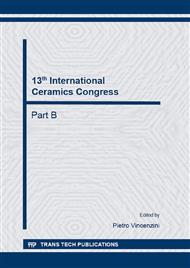p.70
p.74
p.80
p.85
p.94
p.104
p.111
p.121
p.131
Carbonaceous Refractory Materials on SHS-Technology
Abstract:
This study contains results of carbonaceous SHS-refractory materials application for binding of the graphite products and melting of metals in the induction furnaces. The opportunity of producing strong graphite-graphite bond up to 5 MPa by means of the carbonaceous refractory material that demonstrated high chemical stability in the aggressive liquid metals and alloys environment has been shown. The results of the industrial tests of melting crucibles made of carbonaceous SHS-refractory materials have been presented in the case of aluminium melting. It has been shown that such crucibles stability is 5-6 times higher than that of standard graphite crucibles in aluminium melting conditions. The obtained research results testify that developed carbonaceous material is applied for lining of the induction furnace of melting unit is allow to increase the number of nonferrous metals (bronze) melting cycles from 5 to 6 times in comparison with the traditional graphite crucible melting. High chemical stability of the material to oxidizing environment as well as to metal melts is provided by formation of high-melting compounds in the carbonaceous exothermic systems during SHS-process.
Info:
Periodical:
Pages:
94-103
Citation:
Online since:
October 2014
Authors:
Keywords:
Price:
Сopyright:
© 2014 Trans Tech Publications Ltd. All Rights Reserved
Share:
Citation:


